The last of the turkey or ham has been sandwiched between bread and eaten, the fruitcake and Panettone, the cookies and the stollen all devoured. The gifts have all been opened and enjoyed and the last card has been stamped, sealed, and sent. New Year’s festivities are come and gone, resolutions made or not. Now we approach the 6th day of January, the Twelfth Day of Christmas, the Epiphany, Three Kings' Day, one of the most ancient celebrations in Christianity. It is on this day, as the story goes, the 3 Magi arrived in Bethlehem and carried gifts to the baby Jesus. The French fête this occasion with a very special pastry, la Galette des Rois, The Kings' Cake. And whether Christian or not, this confection is too good not to celebrate.
We all know that many well-known and loved symbols and traditions of Christmas are originally of ancient pagan origin: the decorated tree, mistletoe, the Yule log, caroling, among others. In fact, during the early years of the religion, the Christmas festivities were actually pushed up to the end of the year to coincide with the Winter Solstice, overlapping the pagan Saturnalia, a most popular Roman celebration marked by rambunctious behavior, overall silliness, and fun and games, somewhat more joyous than the traditionally solemn Christian celebrations. Incorporating the joyous, more *rambunctious* festivities into the usually sober Christmas rites may very well have been a way to keep the faithful, well, faithful.
As early as Roman times, the tradition of naming a “king for the day” during the Saturnalias festivities existed. Saturn, considered an angry dethroned king in exile, had to be kept at bay, the disorder of the “evil days of Saturn” thwarted. So a new king was named to take away the power from Saturn. The idea of a “king’s cake” was part of the festivities. Each great family had a banquet during which a cake was cut and served to the entire household, slaves and later servants included. A bean tucked into the cake being the prize that would designate the king - or more likely the prince, the « Saturnalicius princeps » - from among the slaves, in later ages, from among the servants.
To insure the random distribution of slices of cake, giving everyone his or her fair chance of finding the prize, it became custom for the youngest member of the party to sit under the table, where he or she couldn’t see the cake being sliced and thus able to catch a glimpse of the bean or token, and shout out the name of the recipient of each slice.
The one designated king was given the power to have every wish or desire granted throughout the day - and as the role of king and servant were flipped - this included giving orders to his master.
It was in 567 A.D. that the Catholic Council of Tours (fun fact: Tours is just a 40 minute drive from where I live in Chinon) "proclaimed the twelve days from Christmas to Epiphany as a sacred and festive season." (Another fun fact: during this same Council, other orders of the day included deciding that a married bishop should treat his wife as a sister and married priests, deacons, and subdeacons should have their wives sleep together with the maidservants.)
It is thought that originally the day of Jesus' birth, celebrated on December 25, was reserved for strictly religious observance while the Epiphany, January 6 was a day of celebration, the day of giving and receiving gifts, a day in which some of the less than religious practices were merged with the gift-giving of the Magi. Interestingly, of course, this is also tied to another pagan celebration, that of “epiphany” or “light”, a celebratory cycle that begins at the Winter Solstice (falling around December 22), the epiphany or light indicating the day 2 weeks later when the days finally begin to grow longer. It’s claimed that the round shape of the galette des rois, the kings’ cake, symbolizes the sun. With the blending of the early Christian and pagan seasons and festivities, it wasn’t until the Middle Ages where the dates began to be separated into what they are today: December 25 for Christ’s birth and January 6 for the visitation of the Magi or Epiphany/Kings’ Day.
And all of this brings us back around to that ancient tradition of the cake, the bean, and king-for-a-day: while a similar treat was served and eaten on most festive occasions when frivolity was called for, the galette slowly found its way to representing Epiphany.
During the course of the Middle Ages, the tradition of the galette served on Epiphany began to spread and take hold. But it was no longer the custom for he or she who had discovered the bean or charm in the cake to have their every whim answered, their every wish granted. It became custom - an obligation, really - for the king simply to buy a round of drinks for everyone in the room. But those who were too stingy to pay would often just swallow the bean with the cake to worm out of being named and the accompanying obligation. To avoid cheating, the bean was eventually replaced with a tiny ceramic charm, less easily swallowed. This ceramic charm or token was often shaped to represent a religious figure but, more often than not, simply a tiny decorative charm, simple or fancy. (Another fun fact: the first porcelain charms were produced in 1874 in Germany; collecting these charms soon became a craze and people today are known to search far and wide and spend crazy sums of money buying special charms for their collections. There’s even a name for this: fabophilia)
In France, the galette des rois is a fixture throughout the month of January and specifically the closest Sunday to the 6th when families and friends gather together around the table to partake of the tradition. In the northern part of the country, the galette is a tart of puff pastry filled with frangipane or almond cream, fruit, usually seasonal apples or pears, or chocolate; in the southern regions, it is a brioche-type cake studded with candied fruit.
But galette or brioche, there is always a lucky charm buried in the cake. And to this day, when the cake is served, the ritual of the child under the table shouting out the name of the recipient of each piece still exists. And, yes, whoever finds the charm or token in their slice of galette is named King for the Day, the accompanying paper crown perched atop his or her head. And today, the king’s role is to offer guests… another galette! Today’s celebration is no longer religious but rather one of indulgence, conviviality, frivolity, and merry-making. Full circle, indeed.
Beginning just after the New Year, glass cases in every French pastry shop and bakery are lined with Galettes des Rois, filled not only with the traditional almond cream but with a wide variety of fillings for every taste. Every year I buy one or two over the course of the month of their short-lived appearance and we all enjoy these wonderful, rich confections. But when I can, I make my own! It starts with homemade puff pastry, easy to make although rather time consuming, or store bought if you like, and then simply filled with either frangipane, a luscious filling of ground almonds, softened butter, sugar, and an egg and flavored with rum and vanilla, or an apple compote, or pastry cream. And a fève - a charm or token - of course, tucked inside for one lucky king.
Enjoy it, for the season is short.
La Galette des Rois or Kings’ Cake
Layer upon layer of flaky golden pastry, its sugary, buttery flakes cradling a rich, rum-kissed almond cream in which hides a very special prize. And like all great French fashion, it comes with the perfect accessory: a golden crown.
If using homemade puff pastry, prepare the dough first and allow it to rest in the refrigerator while preparing and chilling the filling. If using store-bought puff pastry, prepare your choice of filling first and give it time to cool or chill and firm up before preparing the galette.
About 1 - 1 ½ lbs (500 - 600 grams) homemade all-butter puff pastry or two store-bought rounds
Prepare one of the fillings below and allow to either chill or come to room temperature, as indicated in each recipe, while preparing the puff pastry.
TRADITIONAL FRANGIPANE FILLING
2 ½ ounces (70 grams) sugar
2 ounces (60 grams) unsalted butter softened to room temperature
1 large egg
2 ½ ounces (70 grams) ground almonds, hazelnuts, or unsalted pistachios
¼ teaspoon vanilla
1 tablespoon dark or amber rum
Egg wash (1 yolk whisked with 1 teaspoon cold water)
Icing/powdered sugar for generously dusting the top of the Galette for the "crust".
Beat the sugar and butter together until fluffy. Beat in the egg, the ground almonds or other ground nut, the vanilla, and the rum. Add more vanilla or rum to taste, if desired. Place the filling in a small bowl covered with plastic wrap or in a lidded plastic container and refrigerate until ready to use. It needs to firm up before assembling the cake.
For a fruity twist on the traditional frangipane filling, fold in 2 tablespoons of good quality cherry preserves before chilling.
VANILLA BEAN APPLE PASTRY CREAM
Smaller batch Pastry Cream:
2 tablespoons cornstarch
6 tablespoons (90 grams) sugar
1 large egg
2 large egg yolks
2 tablespoons (30 grams) unsalted butter (preferably at room temperature)
Small pinch salt
1 cup (250 ml) whole milk (I use 2% low fat)
½ teaspoon vanilla extract or ½ a vanilla bean, split down the center, seeds scraped out
Larger batch Pastry Cream:
3 tablespoons cornstarch
½ cup (100 grams) sugar
1 large whole egg
3 large egg yolks
2 tablespoons (30 grams) unsalted butter (preferably at room temperature)
Pinch salt
2 cups (500 ml) milk (I use 2% low fat)
1 teaspoon vanilla or 1 vanilla bean, split down the center, seeds scraped out
Sift the cornstarch into a medium-large heatproof bowl and stir or whisk with half the sugar. Add the whole egg and the yolks and whisk until smooth and thick.
Place the butter, the remaining sugar, the pinch of salt, the milk, and both the vanilla bean pod and the seeds (if using a bean) in a saucepan and bring just to the boil. Remove from the heat.
Pour the hot milk into the egg mixture in a slow stream a ladleful at a time, whisking constantly so that the eggs do not curdle or begin to cook; this will gradually heat the eggs. Once all of the hot milk has been added to the egg mixture, pour it all back into the casserole and return to a very low heat. Whisking constantly, bring the cream to a gentle boil and cook for 2 to 3 minutes. The pastry cream may thicken rapidly but cooking for 2 minutes or so eliminates the cornstarch flavor.
If using liquid vanilla extract, add it to the cooked pastry cream. If using the vanilla bean, remove the pod and discard; the vanilla seeds will leave beautiful dark speckles in the pastry cream.
If you like, fold in cinnamon caramelized apple chunks made from about 2 apples. (*see recipe below).
Immediately pour and scrape the pastry cream into a clean heatproof bowl, cover with plastic wrap, pushing the plastic onto the surface of the cream to keep a skin from forming. Allow the cream to cool slightly as you prepare the puff pastry; do not prepare this too far in advance or cool too much as the pastry cream must still be soft and creamy enough to easily spread on the puff pastry round.
Prepare the Caramelized Apple Filling:
2 pie/tart or baking apples
1/8 cup (25 g) granulated brown or white sugar
1 Tbs (15 g) butter
¼ tsp ground cinnamon
Peel and core the apples. Chop into very small cubes. Heat a large skillet and, over low heat, add the sugar and allow it to melt and begin to color. Add the butter and stir, allowing it to cook very briefly until a light caramel forms. Add the cubes of apple and toss and stir quickly to coat with the caramel; if some of the caramel has solidified, simply continue to cook the apples, stirring often, and the caramel will melt and blend with the apples. Cook the apples for 10 or 15 minutes over low or medium-low heat, stirring often, until tender – more or less so as desired. Remove from the heat and stir in the ground cinnamon. Allow to cool to room temperature before assembling the Galette.
APPLE MAPLE FILLING
You can always make more and keep the extra on hand for tasty applesauce!
4 apples, preferably Belle de Boskoop or a similar type, sweet and flavorful for applesauce
1 ½ - 2 tablespoons (22 - 30 grams) unsalted butter
1/8 to ¼ cup (25 to 50 grams) granulated sugar
2 to 3 tablespoons pure maple syrup
Ground cinnamon
Peel, core and slice the apples. Melt the butter in a large skillet. Add the granulated sugar and stir until the mixture is smooth, grainy and bubbling. Add the apple slices and toss to coat; cook the apples until soft, about 5 minutes, then stir in 1 to 1 ½ tablespoons maple syrup and a dash of cinnamon, stir until well blended, and continue cooking for up to about 5 minutes more, stirring often, until the apples are very soft and beginning to fall apart into a purée. Remove from the heat and purée, either with a fork or an emulsion mixer; taste and add more maple syrup and/or cinnamon as desired. Allow to cool to room temperature.
To prepare the Galette des Rois:
Roll out the puff pastry to a thickness of ½ inch (1 cm) and not less than 3/8 inch, long and wide enough to cut out two 8 or 8 ½-inch (21 cm) discs; you can make it bigger but just make sure it’s easy to handle getting in and out of the oven. Using a cake tin or plate of about 8- or 8 ½-inches (21 cm) diameter and using a very sharp knife, trace and cut out two discs. Place each disc carefully on parchment-lined baking sheets, cover with plastic wrap and let rest in the refrigerator for 30 minutes.
If using homemade puff pastry, stack any remaining dough (don't mash together into a ball as you would other dough), wrap in plastic wrap and store in the refrigerator for another use.
Remove the two prepared pastry rounds from the refrigerator and discard the plastic. Choose one round to be the bottom of the galette and, leaving it on the parchment-lined baking sheet, gently press the edges out a bit with your fingers to enlarge the circle slightly. Mound the cooled or chilled filling in the center of the disc of dough and, using the back of a soup spoon, spread and press the filling out smoothly to a thickness of about ½ inch (1 cm) but no more than ¾ inch, leaving a ½ inch (1 cm) to ¾ inch border of dough free around the edges. Press a fève, a ceramic charm of some sort, or even an old-fashioned dried bean or a coin into the filling, if desired.
Brush the clean ½ inch (1 cm) to ¾ inch border all around with a light coating of egg wash (too wet and the top disc may slide during baking). Gently place the second disc of dough on top of the filling, placing the top and bottom discs’ edge to edge (so the edges meet all the way around), gently stretching the top disc if needed so the edges line up. Press to seal tightly, pressing to have at least one finger width of pastry around all the edges well sealed.
Using a sharp knife held perpendicular to the table, cut into the side edges of the dough to create a scalloped edge all around. Now carefully carve a design into the top of the cakes (not too deeply into the dough), making a couple or few small vents through the dough. Brush the top and sides of the galette lightly with egg wash. Place the baking tray in the refrigerator for the time the oven takes to preheat.
Preheat the oven to 425°F (220°C).
Place the baking tray with the galette in the hot oven and bake for 20 minutes until the pastry is puffed up and golden brown.
Reduce the oven temperature to 400°F (200°C) and continue baking for an additional 25 to 30 minutes until the sides of the pastry are also golden and crisp and the pastry is well risen. If you think the pastry is browning too quickly, simply lay a piece of foil loosely over the top.
Remove the galette from the oven and move the rack up one notch. Generously dust the entire top surface of the galette with powdered sugar then place the pastry back in the oven. Now bake for around 5 minutes until the sugar has turned to a golden and very shiny glaze. Stand next to your oven and watch because the perfect glaze can very quickly burn in the flash of an eye! You must watch so you can pull it out of the oven just as the last of the top turns a gorgeous golden and not leave it one second longer. Remove the Galette from the oven and slide the parchment paper with the galette off onto a cooling rack. Allow the Galette to cool before serving.
Serve warm (not hot) or at room temperature. Make sure there is a child under the table while the host slices and then passes each slice as the child calls out whom to serve. Have a paper crown ready to crown the King who finds the charm! And let the merrymaking begin!
You can also make individual galettes!
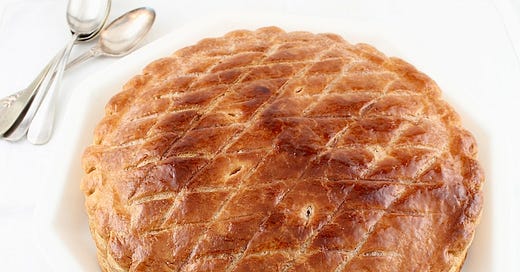



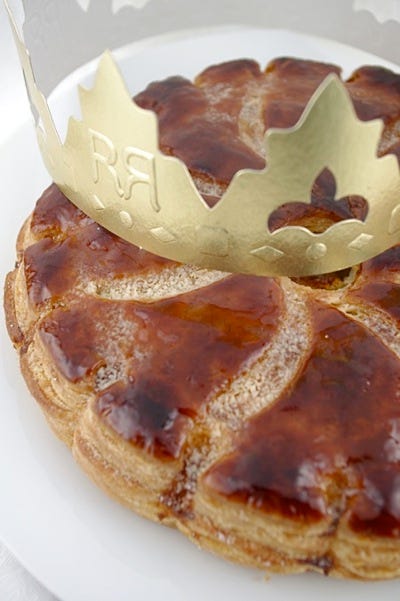
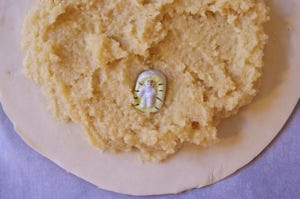



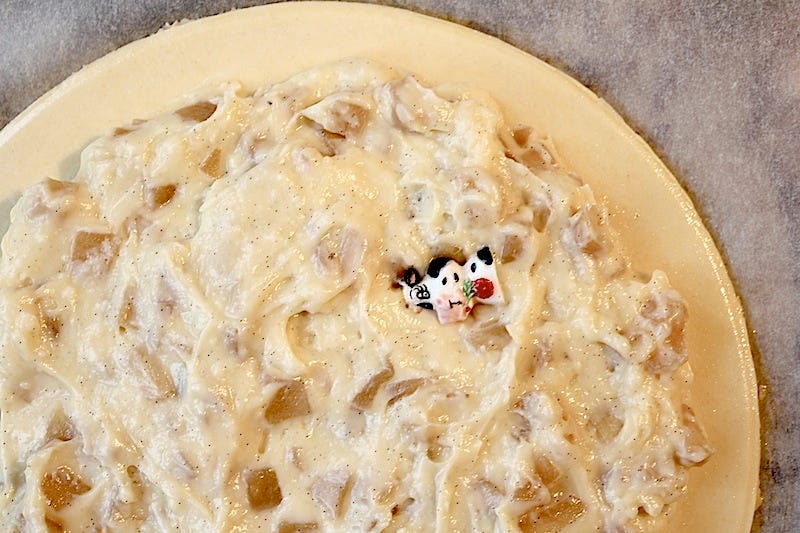
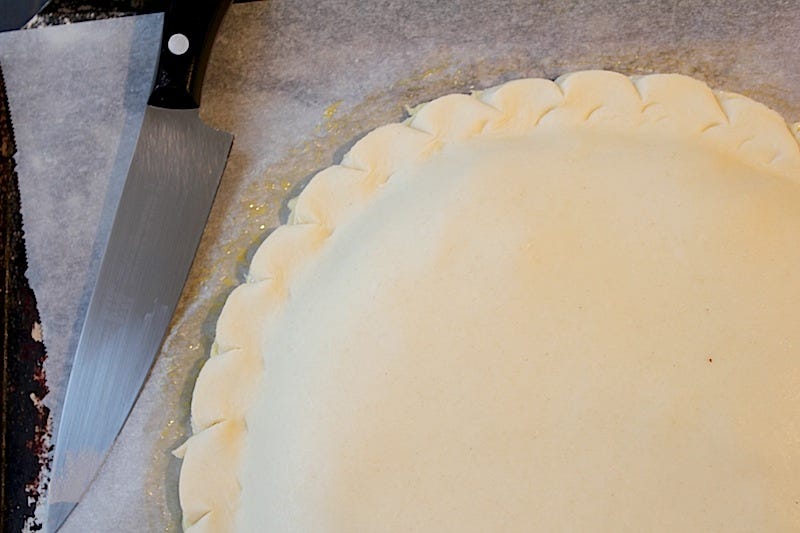
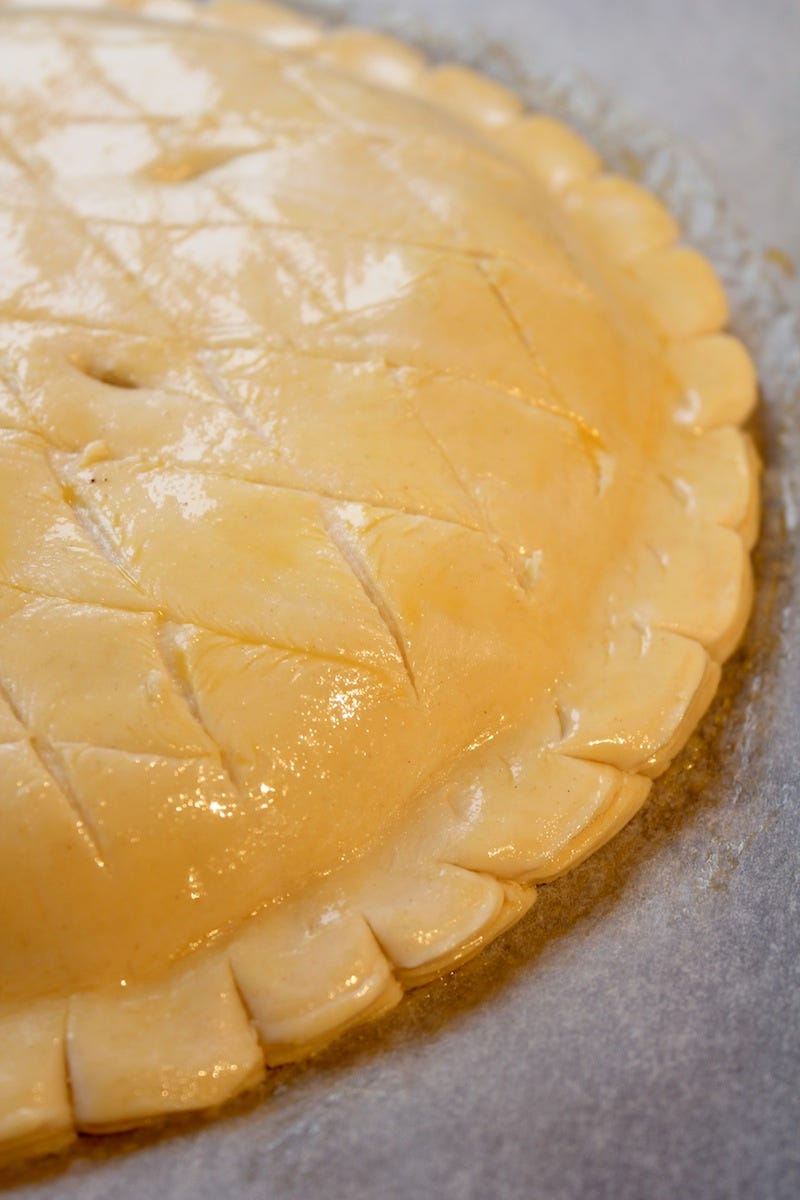
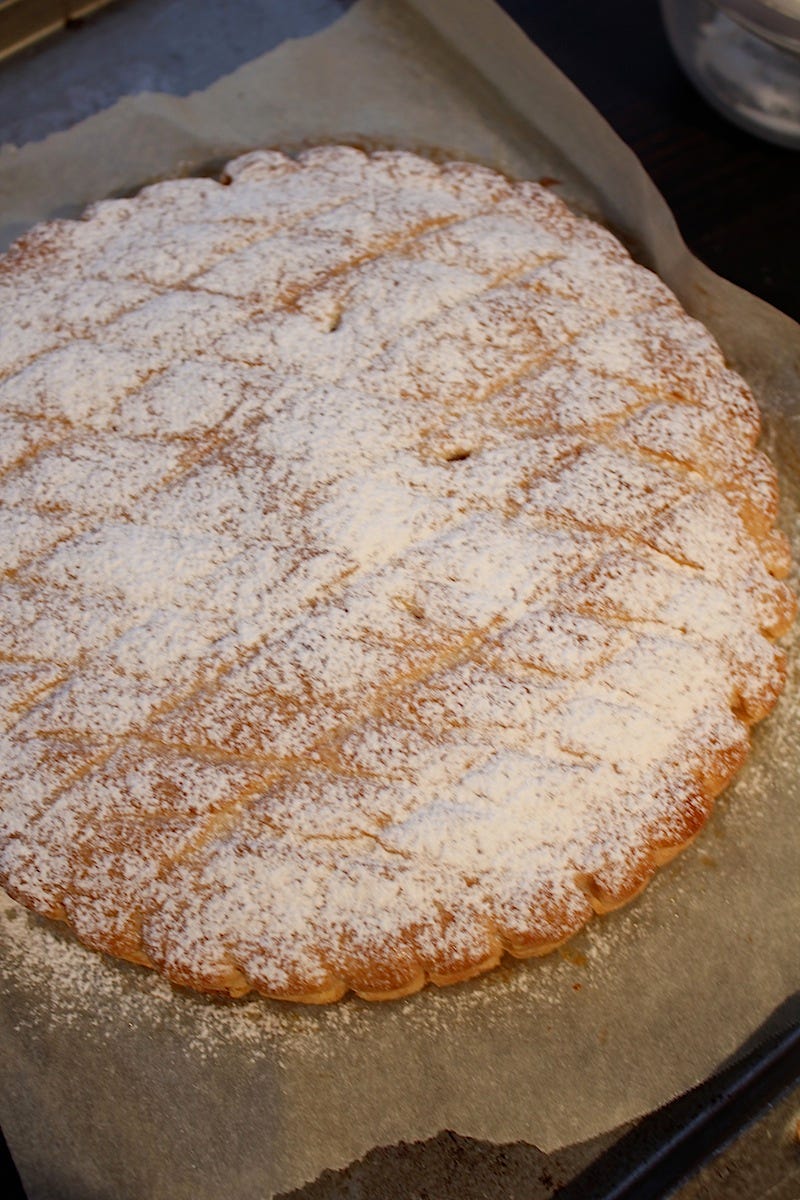


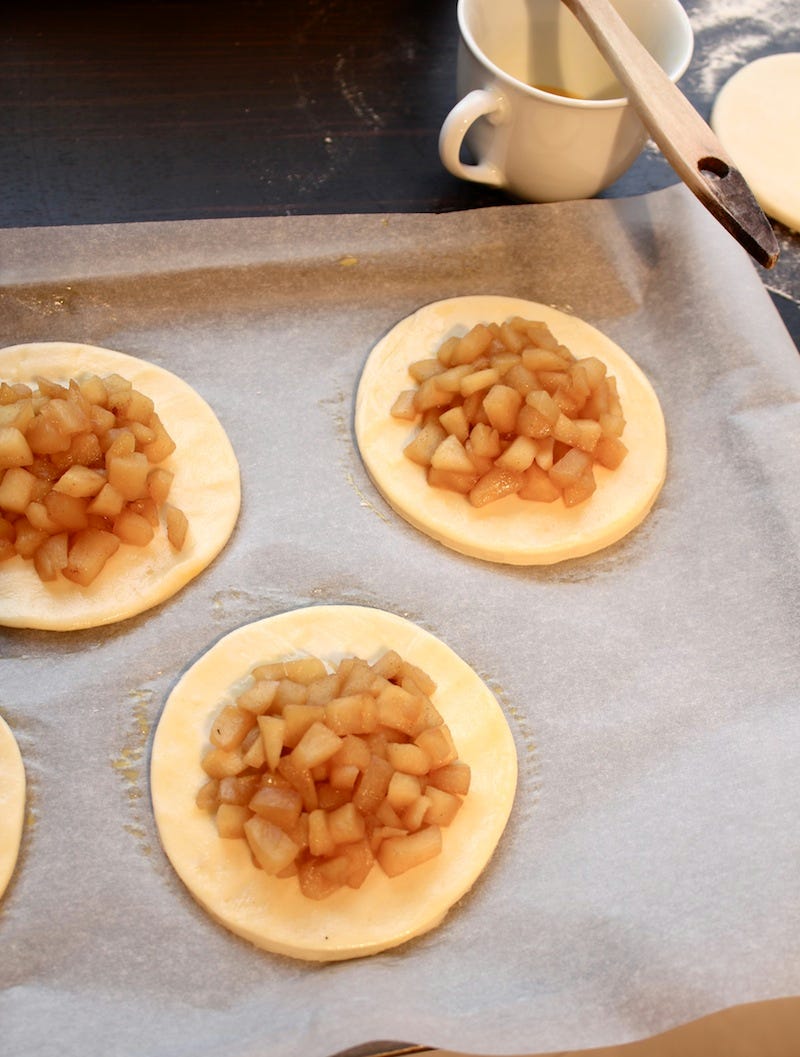
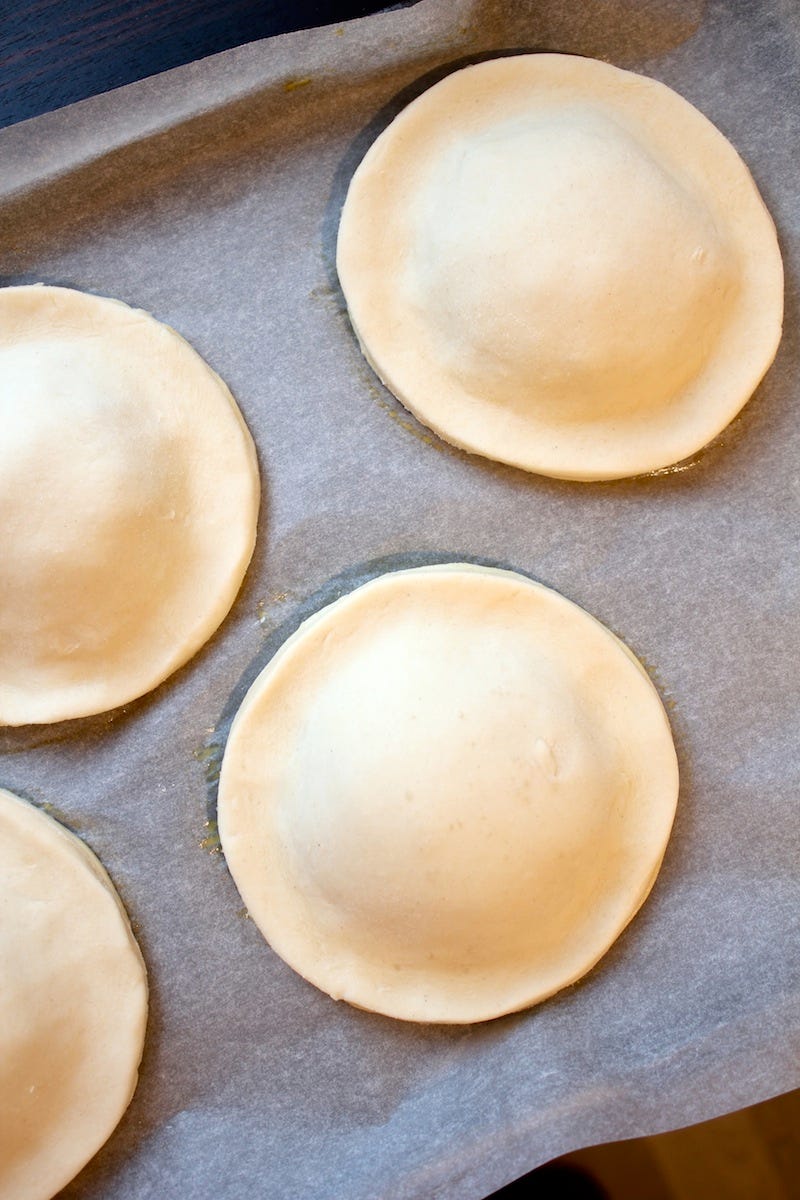

Beautiful post with great recipes and the best explanation I have seen of La Galette des Rois
Fantastic, Jamie!